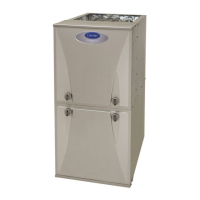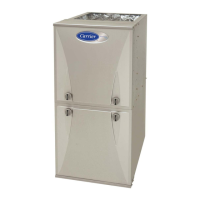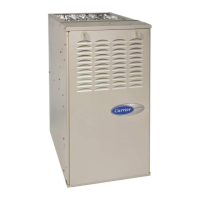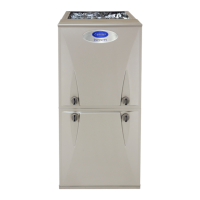PG96MSA: Installation, Start-up, Operating and Service and Maintenance Instructions
Manufacturer reserves the right to change, at any time, specifications and designs without notice and without obligations.
8
All fuel-burning equipment must be supplied with air for fuel
combustion. Sufficient air must be provided to avoid negative pressure
in the equipment room or space. A positive seal must be made between
the furnace cabinet and the return-air duct to prevent pulling air from the
burner area.
AIR FOR COMBUSTION AND VENTILATION
Introduction
Direct Vent (2-pipe) Applications
When the furnace is installed as a 2-pipe furnace, no special provisions
for air for combustion are required. However, other gas appliances
installed in the space with the furnace may require outside air for
combustion. Follow the guidelines below to ensure that other gas
appliances have sufficient air for combustion.
Direct Vent (1-pipe) Applications
When the furnace is installed as a 1-pipe furnace, it will be necessary to
ensure there is adequate air for combustion. Other gas appliances
installed with the furnace may also require air for combustion and
ventilation in addition to the amount of combustion air and ventilation
air required for the furnace. Follow the guidelines below to ensure that
the furnace and other gas appliances have sufficient air for combustion.
Ventilated Combustion Air Applications (for U.S. Only)
When the furnace is installed using the ventilated combustion air option,
the attic or crawlspace must freely communicate with the outdoor to
provide sufficient air for combustion. The combustion air pipe cannot be
terminated in attics or crawlspaces that use ventilation fans designed to
operate during the heating season. If ventilation fans are present in these
areas, the combustion air pipe must terminate outdoors as a 2-Pipe
system.
All air for combustion is piped directly to the furnace from a space that is
well ventilated with outdoor air (such as an attic, crawl space or
equipment closet) and the space is well isolated from the living space or
garage. In addition, other gas appliances installed in the space with the
furnace may require outside air for combustion. Follow the guidelines
below to ensure that the roof or crawlspace walls have sufficient free
area to provide sufficient air for combustion and ventilation for the
furnaces. The guidelines below can be used to ensure that other gas
appliances have sufficient air for combustion.
Provisions for adequate combustion, ventilation, and dilution air must be
provided in accordance with:
• U.S.A. Installations: Current edition of Section 9.3 of the NFPA
54/ANSI Z223.1, Air for Combustion and Ventilation and applicable
provisions of the local building codes.
CAUTION
!
PERSONAL INJURY AND/OR PROPERTY DAMAGE
HAZARD
Improper use or installation of this furnace may result in premature
furnace component failure. Unless otherwise prohibited, this gas
furnace may be used for heating buildings under construction provided
that:
- The furnace is permanently installed with all electrical wiring,
piping, venting and ducting installed according to these
installation instructions. A return air duct is provided, sealed to
the furnace casing, and terminated outside the space containing
the furnace. This prevents a negative pressure condition as
created by the circulating air blower, causing a flame rollout
and/or drawing combustion products into the structure.
- The furnace is controlled by a thermostat. It may not be “hot
wired” to provide heat continuously to the structure without
thermostatic control.
- Clean outside air is provided for combustion. This is to
minimize the corrosive effects of adhesives, sealers and other
construction materials. It also prevents the entrainment of
drywall dust into combustion air, which can cause fouling and
plugging of furnace components.
- The temperature of the return air to the furnace is maintained
between 55°F (13°C) and 80°F (27°C), with no evening setback
or shutdown. The use of the furnace while the structure is under
construction is deemed to be intermittent operation per our
installation instructions.
- The air temperature rise is within the rated rise range on the
furnace rating plate, and the gas input rate has been set to the
nameplate value.
- The filters used to clean the circulating air during the
construction process must be either changed or thoroughly
cleaned prior to occupancy.
- The furnace, ductwork and filters are cleaned as necessary to
remove drywall dust and construction debris from all HVAC
system components after construction is completed.
- Verify proper furnace operating conditions including ignition,
gas input rate, air temperature rise, and venting according to
these installation instructions.
WARNING
!
CARBON MONOXIDE POISONING / COMPONENT
DAMAGE HAZARD
Failure to follow this warning could result in personal injury or death
and unit component damage.
Corrosive or contaminated air may cause failure of parts containing flue
gas, which could leak into the living space. Air for combustion must not
be contaminated by halogen compounds, which include fluoride,
chloride, bromide, and iodide. These elements can corrode heat
exchangers and shorten furnace life. Air contaminants are found in
aerosol sprays, detergents, bleaches, cleaning solvents, salts, air
fresheners, and other household products. Do not install furnace in a
corrosive or contaminated atmosphere. Make sure all combustion and
circulating air requirements are met, in addition to all local codes and
ordinances.

